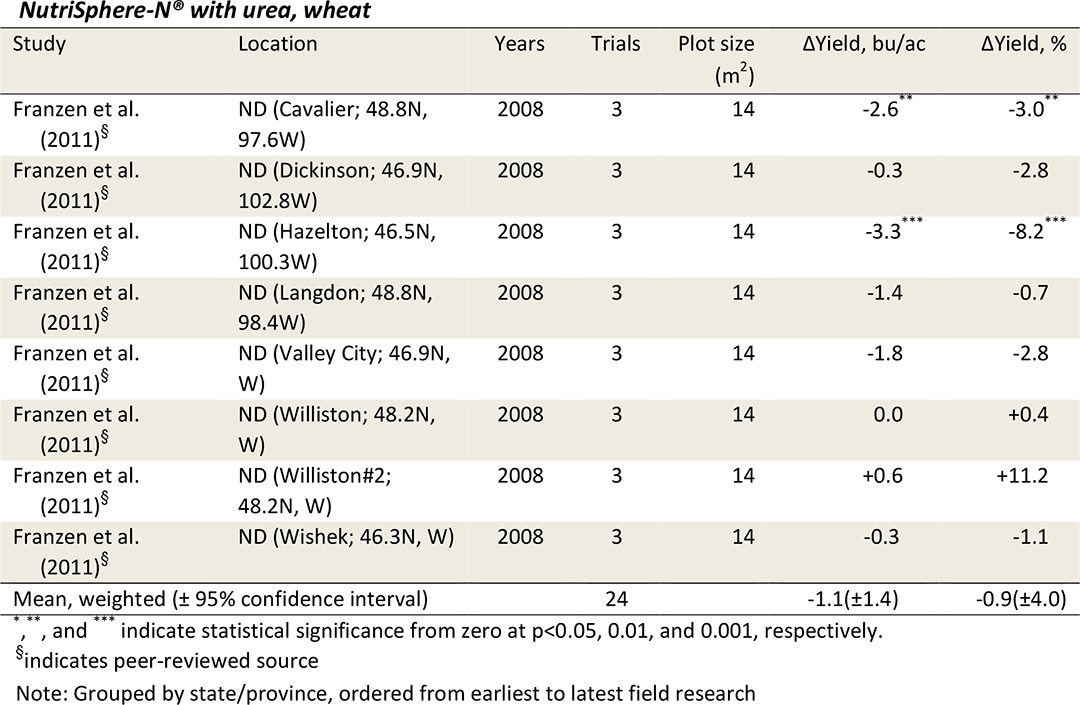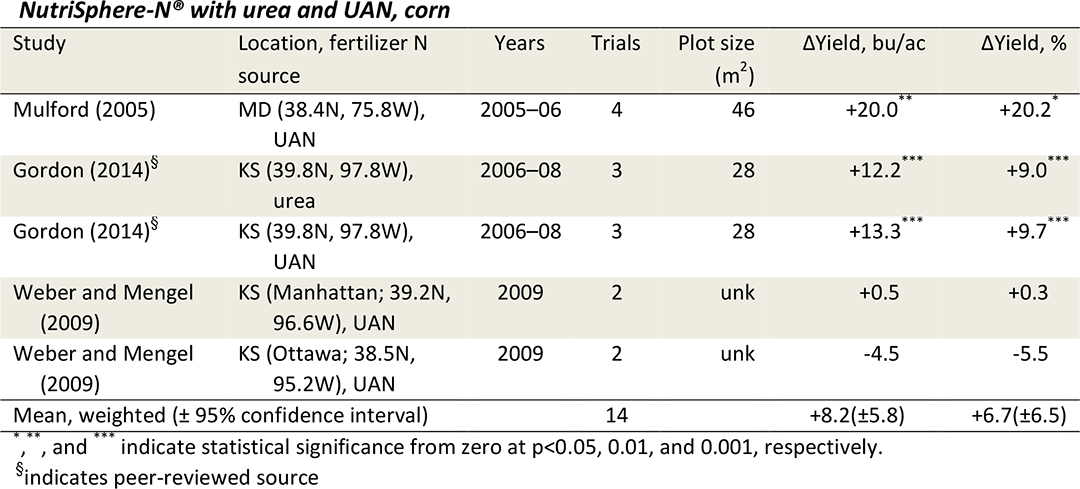NutriSphere-N® Research Findings
The research findings reported here were obtained from a literature review performed by Alison Eagle of Duke University (Nicholas Institute for Environmental Policy Solutions) in March 2016 under contract to the Environmental Defense Fund.
NutriSphere-N® (also known as NutriSphere-N® Nitrogen Fertilizer Manager, or N-N) is a polymer-based, enhanced-efficiency fertilizer product made and distributed by Verdesian Life Sciences that can be combined with various N fertilizer sources. It can be coated onto granular fertilizers like urea, or injected into UAN solutions. Like many enhanced efficiency fertilizers, NutriSphere-N® is advertised to improve crop consumption and increase yield by decreasing the rates of nitrogen loss via volatilization, leaching, and denitrification through suppression of urease and nitrification activity. NutriSphere-N® is a relatively new enhanced-efficiency fertilizer product, but it has been tested in the laboratory and a variety of North American field locations since the early 2000s. It has also used by farmers on over 30 million acres in 40 states (Verdesian 2015).
The NutriSphere-N® polymer was evaluated in early laboratory experiments on jackbean at the University of Kentucky, where it was shown to inhibit nitrification as well as urease activity, with the amount of inhibition ranging from 22 to 46% (Coyne 2009). Following other laboratory experiments in North Dakota and Arkansas, Franzen et al. (2011) concluded that NutriSphere-N® had “no nitrification or urea volatilization inhibiting properties”. Some of the same researchers continued laboratory work, and found that NutriSphere-N® did reduce ammonia volatilization from UAN fertilizer, but with a much lower efficacy than ammonium thiosulfate, NBPT, and calcium thiosulfate (11%, compared to 40%, 51%, and 40%, respectively) (Goos 2013a). The same research lab found very little urease inhibition from NutriSphere-N® (it depended on the rate, at high rates of 500 mg/kg, there was some inhibition, but not nearly as much as with NBPT) (Goos 2013b). Therefore, the laboratory results are mixed.
An early field experiment in Kansas also comparing other conventional and enhanced-efficiency fertilizer products (e.g., AGROTAIN®, ESN®), found NutriSphere-N® to be effective in increasing corn and grain sorghum yields when compared to UAN (Gordon, 2008). Another experiment done in the field demonstrated NutriSphere-N®’s ability to reduce ammonia volatilization as well as AGROTAIN®in both rice and corn crops (Dunn 2010). Later work in North Carolina also supported the findings that NutriSphere-N® can significantly increase corn biomass and resulting grain yield when compared to 30% UAN alone (Heiniger 2014). Another more recent study on cotton in the San Jaoquin Valley of California showed that NutriSphere-N® had the potential to reduce N2O emissions when the fertilizer rate was lower than 100 lbs N/acre, with no significant impact at higher rates of N (Mahal et al. 2014).
A search of the scientific literature and grey literature (conference proceedings, field station reports, etc.) was conducted to locate data on crop yield responses to the products of interest. Data were incorporated into an existing database on fertilizer management field trials, including all available management, climate, soil, N loss, and crop productivity information. The following tables and discussion summarize the yield impacts of NutriSphere-N®. Weighted averages are calculated where possible, with results from each study weighted by the inverse of the number of trials in each location. This prevents studies from very well-studied locations from overwhelming the average results. Overall effect sizes are reported for all studies, with effect sizes also restricted to peer-reviewed data, as applicable.


Note: Grouped by state/province, ordered from earliest to latest field research.
Other field research – for which complete yield data were not available – also studied using NutriSphere-N® as a fertilizer additive. Cahill et al. (2010) reported on a two-year corn trial in North Carolina, finding no wheat or corn yield effects. Other field trials in North and South Carolina found that the product improved corn yields and other growth parameters (Heiniger 2014; Wiatrak 2014). These mixed to somewhat positive results seem similar to the data reported above.
Based on their field experiments from across North Dakota, Franzen et al. (2011) concluded that “spring wheat did not benefit from the application of NutriSphere-N® to urea” when used at the recommended rates. A recent review published in Agronomy Journal looked again at these same yield data, plus observations from an unpublished database of 44 trials testing crop yield response to NutriSphere-N®. They concluded that the product “does not retard urea hydrolysis” and should “not be promoted to farmers as a means to either increase efficiency of fertilizer urea-N…or to enhance crop production” (Chien et al. 2014).
On the other hand, experiments with corn were more likely to have positive yield results from NutriSphere-N®. In an unpublished report, Hatfield and Parkin (2011) noted that NutriSphere-N® yielded 17% more grain corn than urea, but it was not significantly different than corn yield with UAN. These data are not included in the above analysis because the N source associated with NutriSphere-N® was not specified (it was most likely urea, given the mode of application). Parkin and Hatfield (2014) also tested NutriSphere-N® for one year against urea in a different study, finding no impact on cumulative N2O emissions (no yield reported). No other studies were found with reported effects on N2O or NO3 losses.
With the data available, and in the conditions studied, NutriSphere-N® failed to improve crop yield in a consistent manner, even though certain studies found it to be promising. Even with some indication of yield benefits for grain corn, and because of the lack of studies testing N losses, the available data are too limited to conclude that this product improves yield across the board or provides other significant improvements in N efficiency. Therefore, if the product is to be considered further for such purposes and there is any expectation of effectiveness under specific conditions, proof of such is needed. This would require more data collection.
Cahill, S., D. Osmond, R. Weisz and R. Heiniger. 2010. Evaluation of alternative nitrogen fertilizers for corn and winter wheat production. Agronomy Journal 102(4):1226–36.
Chien, S.H., D. Edmeades, R. McBride and K.L. Sahrawat. 2014. Review of maleic-itaconic acid copolymer purported as urease inhibitor and phosphorus enhancer in soils. Agronomy Journal 106(2):423–30.
Coyne, M.S. 2009. Final Report on N-Guard Polymer and Urease Activity, pp. 12. University of Kentucky.
Dunn, D.D. 2010. Corn Ammonia Volatilization Study. University of Missouri, Delta Station, Portageville, MO.
Franzen, D., R.J. Goos, R.J. Norman, T.W. Walker, T.L. Roberts, N.A. Slaton, G. Endres, R. Ashley, J. Staricka and J. Lukach. 2011. Field and laboratory studies comparing NutriSphere-nitrogen urea with urea in North Dakota, Arkansas, and Mississippi. Journal of Plant Nutrition 34(8):1198–222.
Goos, R.J. 2013a. Effects of fertilizer additives on ammonia loss after surface application of urea-ammonium nitrate fertilizer. Communications in Soil Science and Plant Analysis 44(12):1909–17.
Goos, R.J. 2013b. A comparison of a maleic-itaconic polymer and n-(n-butyl) thiophosphoric triamide as urease inhibitors. Soil Science Society of America Journal 77(4):1418–23.
Gordon, W.B. 2014. Management of urea-containing fertilizers for no-tillage corn using nitrogen stabilizers and coated-granule technology. Journal of Plant Nutrition 37(1):87–94.
Hatfield, J.L. and T.B. Parkin. 2011. Evaluation of alternative forms of nitrogen fertilizer on agronomic performance and nitrous oxide emissions. National Laboratory for Agriculture and the Environment, Ames, IA. 4 pp.
Heiniger, R. 2014. The impact of the polymer coating NutriSphere™ in increasing nitrogen use efficiency and corn yield. American Journal of Agricultural and Biological Sciences 9(1):44–54.
Mahal, N.K., G. Goorahoo, B. Roberts and F.C. Sharma. 2014. Nitrous oxide emission factors for cotton fertilized with urea ammonium nitrate and treated with NutriSphere-N. In Proceedings of the, Fresno, California.
Mulford, R. 2005. NutriSphere-N effects on no-till corn yield. University of Maryland, Lower Eastern Shore Research and Extension Center, Quantico, MD.
Parkin, T.B. and J.L. Hatfield. 2014. Enhanced efficiency fertilizers: effect on nitrous oxide emissions in Iowa. Agronomy Journal 106(2):694–702.
Verdesian. 2015. Nutrisphere-N Nitrogen Fertilizer Manager. [Online]. Verdesian Life Sciences. http://www.vlsci.com/products/nutrient-management-efficiency-technologies/nutrisphere-n (verified Feberuary 22 2016).
Weber, H.S. and D.B. Mengel. 2009. Use of nitrogen management products and practices to enhance yield and nitrogen use efficiency in no-till corn. 39th North Central Extension-Industry Soil Fertility Conference Proceedings 25:1–7.
Wiatrak, P. 2014. Evaluation of nitrogen application methods and rates with NutriSphere-N on soil nitrate-nitrogen in southeastern coastal plains. American Journal of Agricultural and Biological Sciences 9(1):109–18.
